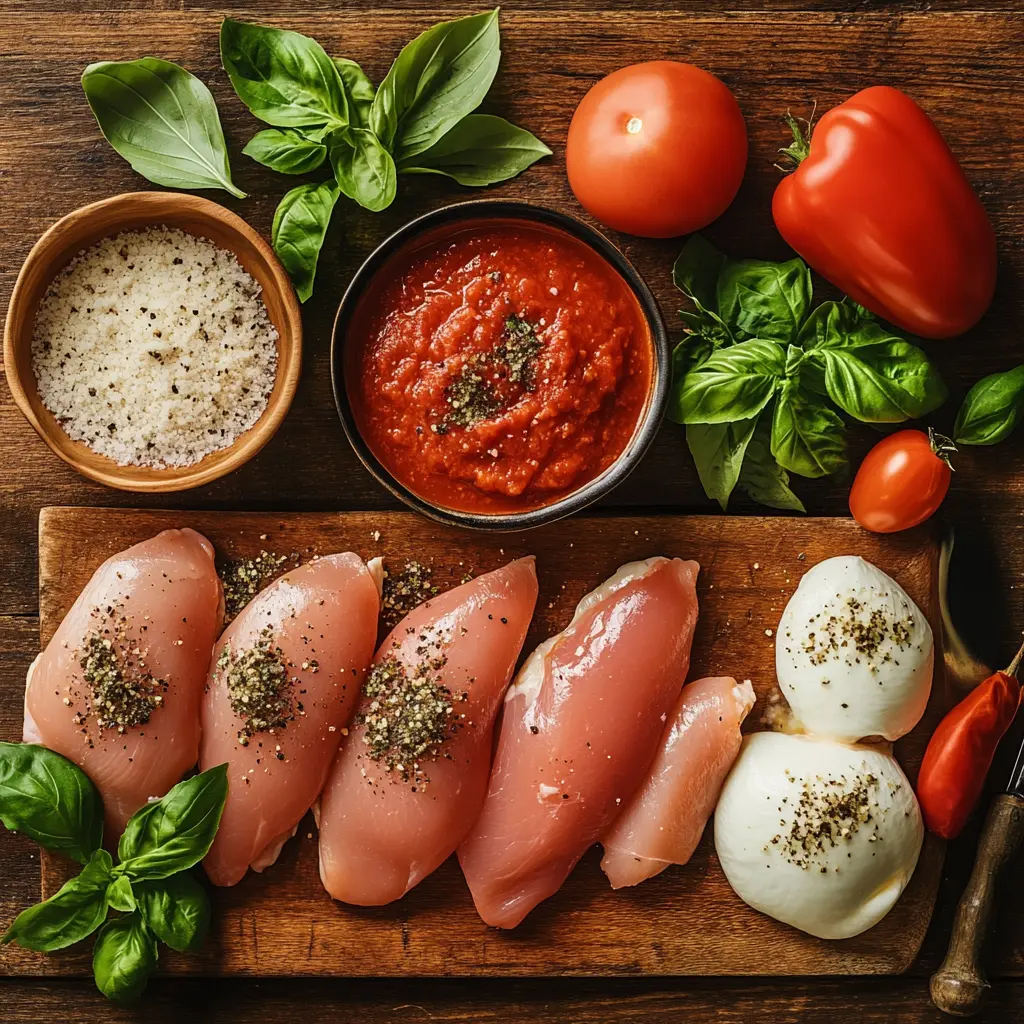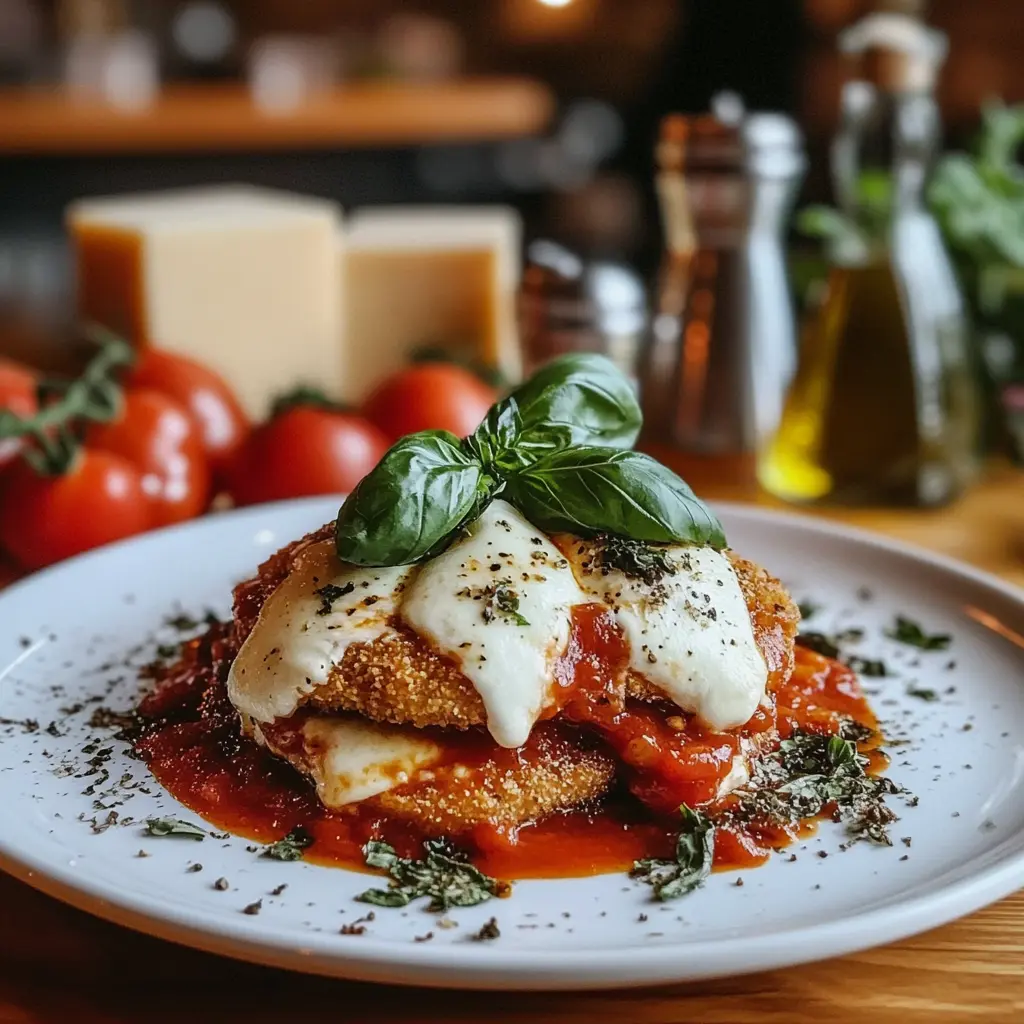Chicken Parmesan, or Chicken Parmigiana, is a beloved classic, yet it sparks an intriguing culinary mystery: Why is it called Chicken Parm when mozzarella is the star cheese? This article explores the dish’s fascinating history, its evolution across cultures, and the role of its key ingredients. From traditional Italian roots to its adaptation in the American culinary scene, we uncover the secrets behind the name, the cheese, and the cultural significance of this deliciously confusing dish.
Part 1: Origins of Chicken Parmesan
The roots of Chicken Parmesan reach deep into Italian culinary traditions, specifically drawing inspiration from Parmigiana di Melanzane—a classic eggplant dish. Originating in Southern Italy, particularly in regions like Campania and Sicily, this dish combines layers of fried eggplant, tomato sauce, and cheese. While chicken wasn’t the primary protein in the original recipe, the concept of layering and baking with cheese and tomato sauce became a hallmark of Italian comfort food.
A Dish Born from Adaptation
Interestingly, chicken wasn’t widely used in traditional Italian cooking due to its cost and limited availability. Eggplant, a staple in Southern Italian cuisine, was more accessible. However, as Italian immigrants settled in America during the late 19th and early 20th centuries, they adapted their recipes to suit the ingredients and preferences of their new home. Thus, Chicken Parmigiana was born, transforming the humble eggplant-based dish into one featuring chicken cutlets.
Why Parmesan?
The name “Parmesan” comes from Parmigiano-Reggiano, a hard, aged cheese produced in the Parma region of Italy. While this cheese wasn’t necessarily used in the earliest iterations of the dish, it became synonymous with Italian cooking abroad. The name stuck, even as mozzarella—known for its creamy texture and meltability—became the preferred cheese for layering in the recipe.
Traditional Italian Ingredients
Before diving further into the mystery of the name, it’s important to understand the foundational ingredients that define this dish. Authentic Italian recipes emphasize simplicity and quality. Every ingredient, from the tomatoes to the cheese, is carefully chosen to create a balance of flavor and texture.
The Role of Tomatoes
Tomatoes are the backbone of the dish, offering a tangy, sweet base for the sauce. In traditional recipes, San Marzano tomatoes, prized for their low acidity and rich flavor, are often used. They provide the perfect contrast to the richness of the fried chicken cutlets and melted cheese.
The Cheese Debate
Mozzarella, known for its mild flavor and gooey texture, eventually replaced Parmigiano-Reggiano as the primary cheese in Chicken Parmesan recipes, especially in America. However, Parmigiano-Reggiano still plays a supporting role, often sprinkled on top for a salty, umami finish.
Evolution of the Dish in America
When Italian immigrants brought their culinary traditions to America, they faced a new cultural and economic landscape. Unlike in Italy, where eggplant reigned supreme, chicken was more affordable and readily available in the U.S. This shift marked the beginning of the dish’s evolution from eggplant to chicken.
Adapting to New Tastes
American palates favored larger portions, richer sauces, and heartier meals. Chicken, with its mild flavor and versatility, fit seamlessly into these preferences. Moreover, mozzarella cheese—produced domestically and in abundance—became the go-to cheese for Italian-American dishes, contributing to the transformation of Parmigiana di Melanzane into Chicken Parmigiana.
Restaurant Popularity
The dish gained traction in Italian-American restaurants during the mid-20th century, eventually becoming a staple on menus across the country. It was marketed as both exotic and comforting, appealing to diners eager to experience a taste of Italy without venturing too far from familiar flavors.
Part 2: The Role of Parmesan Cheese
One of the central mysteries surrounding Chicken Parmesan lies in the role of Parmesan cheese—or lack thereof—in the dish. Despite its name, the starring cheese in most versions of Chicken Parmigiana is mozzarella. So, why does Parmesan retain top billing?

A Nod to Tradition
The name “Parmesan” harks back to Parmigiano-Reggiano, a cheese renowned for its complex, nutty flavor and hard texture. Historically, this cheese symbolized Italian culinary excellence. Although mozzarella took center stage in the evolution of the recipe, sprinkling grated Parmesan over the finished dish maintained a connection to its Italian heritage. The name was likely preserved as a nod to the dish’s origins rather than its literal ingredients.
Flavor Complexity
Parmigiano-Reggiano brings a depth of flavor that mozzarella alone can’t provide. Its salty, umami-rich notes balance the sweetness of the tomato sauce and complement the mildness of the chicken. Even in recipes where mozzarella dominates, Parmesan often appears as a garnish, contributing a layer of sophistication and authenticity.
Cultural Branding
The name “Parmesan” also served a practical purpose in the United States. During the mid-20th century, many Italian dishes were marketed with familiar, Italian-sounding names to attract diners. Calling the dish Chicken Mozzarella might not have had the same evocative appeal, especially since Americans associated Parmesan with high-quality Italian cuisine.
Introduction of Mozzarella
While Parmigiano-Reggiano played an important symbolic role, mozzarella’s creamy, meltable nature made it the ideal choice for creating the dish’s iconic gooey topping. Its inclusion revolutionized the way Chicken Parmesan was prepared and enjoyed.
A Cheese Made for Melting
Unlike Parmesan, which has a hard, crumbly texture, mozzarella is prized for its elasticity and ability to melt beautifully. This characteristic gave Chicken Parmesan its indulgent, stringy cheese layer, which became a hallmark of the dish. The visual appeal of melted mozzarella cascading over crispy chicken cutlets was irresistible, especially to diners in America.
Accessibility and Cost
Mozzarella was not only more affordable than Parmigiano-Reggiano but also widely produced in the U.S., thanks to Italian-American cheesemakers. This availability made it a practical choice for restaurants and home cooks alike. Over time, mozzarella became so integral to the dish that many people mistakenly believe it was always part of the recipe.
Regional Variations
As Chicken Parmesan spread across the United States, regional influences shaped its preparation, ingredients, and presentation. These variations added new dimensions to the dish while keeping its core identity intact.
The Classic American Style
The standard American version features breaded chicken cutlets fried to golden perfection, layered with marinara sauce and mozzarella, and baked until bubbly. It’s often served over a bed of spaghetti, turning the dish into a hearty meal rather than just an entrée.
Northeastern Italian-American Influence
In cities like New York and Boston, where Italian-American communities thrived, the dish often sticks closest to its Italian roots. Restaurants in these areas frequently use imported Parmigiano-Reggiano and homemade tomato sauce, emphasizing authenticity.
Southern Twists
In the Southern U.S., you might find Chicken Parmesan with a spicier tomato sauce or even a touch of cream for richness. Some variations incorporate locally available cheeses or alternative breading methods, reflecting regional tastes.
Modern Fusion Variants
In recent years, fusion takes on Chicken Parmesan have emerged, blending the dish with other cuisines. Examples include Chicken Parm tacos, pizza-topped Chicken Parm, or even vegan renditions using plant-based “chicken” and cheese.
Naming Conventions in Italian Cuisine
To unravel the naming mystery further, it’s helpful to examine how Italian dishes are traditionally named. In many cases, names reflect the dish’s region of origin or its key ingredients, but there’s often room for interpretation.
Regional Pride
Italian dishes are frequently named after the regions or cities where they originated. For example, “Parmigiana” likely refers to Parma, where Parmigiano-Reggiano cheese is produced. However, the term doesn’t always mean the dish must include Parmesan cheese—sometimes it’s more about evoking a sense of Italian authenticity.
Creative License in Naming
As Italian recipes were adapted in America, some names were simplified or altered to appeal to local audiences. The term “Parmesan” was easier to pronounce than Parmigiana, and it carried a sense of familiarity for English speakers. This linguistic shift further distanced the dish from its original meaning, creating the delightful confusion we explore today.
Part 3: Influence of Italian-American Culture
The story of Chicken Parmesan wouldn’t be complete without examining the role Italian-American culture played in shaping the dish. When Italian immigrants brought their culinary traditions to the United States, they adapted recipes to fit the resources and preferences of their new communities.
Immigration and Adaptation
During the late 19th and early 20th centuries, waves of Italian immigrants arrived in America, bringing with them a rich culinary heritage. However, they often encountered challenges in replicating traditional dishes due to limited access to authentic ingredients like Parmigiano-Reggiano or fresh eggplant. The abundance of chicken, combined with the American penchant for rich, protein-heavy meals, provided a practical solution. Thus, chicken replaced eggplant as the base of the dish.
The Italian-American Identity
For many immigrants, food became a way to preserve their cultural identity while integrating into American society. Dishes like Chicken Parmesan evolved to reflect this duality—staying true to Italian flavors while embracing the heartiness that appealed to American palates. This blending of cultures gave rise to what is now recognized as Italian-American cuisine, with Chicken Parmesan as one of its flagship dishes.

Misconceptions About the Name
While it’s clear that Chicken Parmesan is deeply rooted in tradition, its name has led to widespread misconceptions about its ingredients and origin.
It’s Not Always About Parmesan
One common misunderstanding is that the dish must include Parmigiano-Reggiano because of its name. However, as discussed earlier, mozzarella often takes the lead role in flavor and texture. The name “Parmesan” persists more as a branding choice than a strict ingredient requirement.
Is It Truly Italian?
Some purists argue that Chicken Parmesan isn’t an authentic Italian dish at all but rather an Italian-American creation. While its roots lie in Italian culinary traditions, the dish as we know it today reflects the innovations and adaptations of immigrant communities in the U.S. This cultural evolution is a testament to the dynamic nature of food and its ability to bridge worlds.
The Culinary Significance of Cheese Selection
Cheese is at the heart of what makes Chicken Parmesan so iconic, and the choice between mozzarella and Parmesan—or both—greatly impacts the dish’s flavor profile and texture.
Mozzarella for Creaminess
Mozzarella adds a creamy, stretchy element that defines the dish’s signature indulgence. Its mild flavor allows the other ingredients, like the tomato sauce and crispy chicken, to shine without overwhelming them.
Parmesan for Complexity
On the other hand, Parmigiano-Reggiano introduces a sharp, nutty complexity that elevates the dish. Even when it plays a supporting role, Parmesan provides a necessary contrast to mozzarella’s mellow richness, ensuring the dish isn’t one-dimensional.
Finding the Balance
Many chefs and home cooks prefer to use both cheeses for a layered flavor experience. A base of mozzarella for texture and a sprinkle of Parmesan for depth ensures that Chicken Parmesan satisfies both tradition and modern tastes.
Comparison with Similar Dishes
Chicken Parmesan shares its culinary DNA with several other dishes, some of which may even predate it. By comparing these recipes, we can better understand its evolution and unique appeal.
Eggplant Parmigiana
As the dish that inspired Chicken Parmesan, Parmigiana di Melanzane features layers of fried eggplant, tomato sauce, and cheese. While it lacks the protein-rich punch of chicken, its vegetarian-friendly nature and use of Parmigiano-Reggiano keep it close to Italian tradition.
Veal Parmesan
Veal Parmesan is another variation that arose alongside Chicken Parmesan in Italian-American kitchens. Using veal cutlets instead of chicken, this dish offers a more tender and delicate texture. However, chicken ultimately became more popular due to its affordability and wider appeal.
Chicken Milanese
Though not baked with sauce and cheese, Chicken Milanese—breaded and pan-fried chicken cutlets—shares similarities with Chicken Parmesan. It represents another example of Italian cuisine’s adaptability, offering a lighter alternative for those who prefer less sauce and cheese.
Modern Interpretations
In today’s culinary landscape, Chicken Parmesan continues to evolve, with chefs and home cooks experimenting to create new takes on the classic dish.
Fusion Creations
Restaurants and food trucks are embracing fusion by incorporating Chicken Parmesan into tacos, sandwiches, and even pizzas. These innovative twists maintain the dish’s core elements—breaded chicken, tomato sauce, and cheese—while presenting them in unexpected formats.
Health-Conscious Alternatives
With growing interest in healthy eating, lighter versions of Chicken Parmesan have emerged. Baked chicken cutlets, reduced-fat cheese, and fresh, homemade tomato sauce offer a guilt-free way to enjoy the dish without sacrificing flavor.
Vegan Variants
For plant-based eaters, vegan versions of Chicken Parmesan use alternatives like breaded tofu or seitan for the protein base, while dairy-free mozzarella and nutritional yeast mimic the cheesy topping. These options ensure that everyone can enjoy a taste of this iconic dish.
Part 4: The Dish in Popular Culture
Over the decades, Chicken Parmesan has cemented its status not just as a culinary staple but also as a cultural icon. Its presence in movies, television, and pop culture at large speaks to its universal appeal and versatility.
A Star in Italian-American Restaurants
From upscale Italian eateries to neighborhood diners, Chicken Parmesan remains a menu favorite. Its comforting flavors and hearty portions make it a crowd-pleaser, often evoking nostalgia for home-cooked meals. Italian-American restaurants, especially in cities like New York and Chicago, often highlight the dish as a cornerstone of their offerings.
Media and Entertainment Spotlight
In pop culture, Chicken Parmesan frequently appears as a shorthand for Italian-American cuisine. Movies and TV shows that feature scenes in Italian restaurants often showcase the dish as part of their storytelling, emphasizing its widespread recognition. For instance, comedic skits and foodie shows sometimes reference it as the quintessential Italian-American comfort food.
A Social Media Sensation
More recently, platforms like Instagram and TikTok have catapulted Chicken Parmesan into the digital food spotlight. Home cooks and professional chefs alike share their versions of the dish, from traditional recipes to creative adaptations. The visual appeal of golden-brown chicken, vibrant red sauce, and oozing melted mozzarella makes it highly shareable and endlessly appetizing.
Health Perspectives on Chicken Parmesan
While undeniably delicious, Chicken Parmesan is often considered indulgent due to its rich ingredients. However, there are ways to enjoy it while keeping an eye on nutrition.
Calorie Content and Modifications
Traditional Chicken Parmesan—with its fried chicken cutlets, cheese, and pasta—is calorie-dense. Yet, small changes can make it more balanced. Baking the chicken instead of frying, using low-fat cheese, and serving it with a side of vegetables instead of pasta can significantly reduce the calorie count without compromising flavor.
Nutritional Benefits
Despite its richness, Chicken Parmesan offers several nutritional benefits. Chicken is an excellent source of lean protein, and tomatoes provide vitamins like C and K, as well as antioxidants such as lycopene. Adding fresh herbs like basil and parsley not only enhances the flavor but also boosts the dish’s nutritional value.
Mindful Portions
For those looking to indulge while maintaining a healthy lifestyle, portion control is key. Enjoying a smaller serving of Chicken Parmesan alongside a fresh salad or steamed vegetables allows for a balanced, satisfying meal.
Conclusion
Exploring the question, “Why is it called Chicken Parm if it’s made with mozzarella?” reveals a fascinating blend of history, culture, and culinary evolution. From its roots in Italy to its transformation in America, Chicken Parmesan embodies the adaptability and creativity of Italian-American cuisine. The dish’s name may spark curiosity, but its universal appeal lies in its ability to bring comfort, flavor, and tradition to every table.
Whether you enjoy it as a classic entrée, a modern fusion twist, or a lighter alternative, Chicken Parmesan continues to capture hearts and taste buds worldwide, proving that a great dish transcends labels and definitions.

